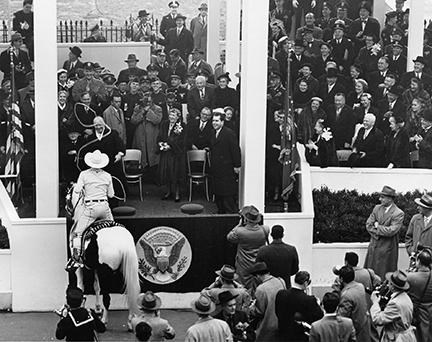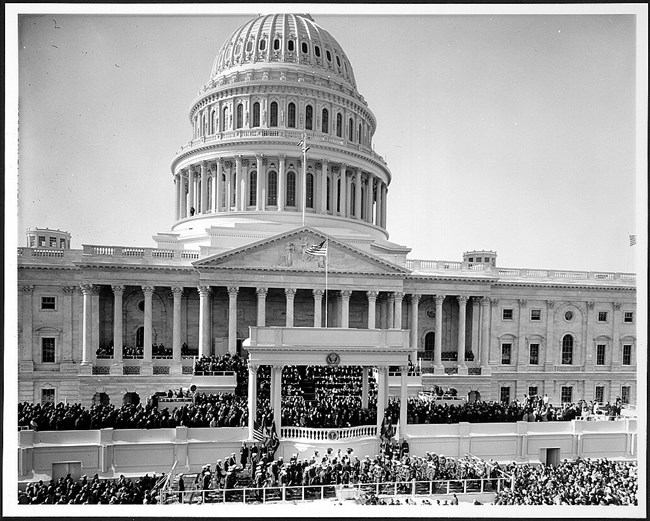Last updated: December 7, 2022
Article
January 20: The Beginning and the End: Ike's First and Last Inaugurations

Photograph Courtesy of Eisenhower Presidential Library
January 20, 1953 was the date Ike's presidency officially began - the date of his first inauguration. January 20, 1961 was also the date of President Kennedy's inauguration – and Ike's very last day as president.
January 20, 1953 was a fairly balmy day for a presidential inauguration - cloudy but with a noontime temperature of 49. Truman and Ike arrived together at the Capitol in the White House Lincoln, both wearing homburgs instead of the traditional top hats. Ike was sworn in on the East Portico by Chief Justice Frederick Vinson on two bibles: one used by George Washington when he took the oath to become the first president in 1789 and the other Ike's personal West Point Bible. Ike then broke from tradition and prefaced his inaugural address by reciting a prayer that he had written that morning. His address was 2446 words. It returned again and again to the notions of peace and freedom, strength and security.
The inaugural parade went on for 4 hours and 39 minutes. 750,000 spectators lined the parade route. Ike and Mamie led the parade riding together in a white Cadillac with the top down, the first time a new President and First Lady had ever ridden together in the parade. Ike and Mamie watched the remainder of the parade from the reviewing stand in front of the White House accompanied by former President Herbert Hoover, General George Marshall--Ike's WWII boss--and Mrs. Clare Booth Luce. Perhaps the highlight of the day was when a palomino-riding California cowboy in the parade, Marty Montana, paused in front of the reviewing stand and lassoed the President. The moment was captured by a Life photographer.

Courtesy of the Eisenhower Presidential Library
The inaugural parade went on for 4 hours and 39 minutes. 750,000 spectators lined the parade route. Ike and Mamie led the parade riding together in a white Cadillac with the top down, the first time a new President and First Lady had ever ridden together in the parade. Ike and Mamie watched the remainder of the parade from the reviewing stand in front of the White House accompanied by former President Herbert Hoover, General George Marshall--Ike's WWII boss--and Mrs. Clare Booth Luce. Perhaps the highlight of the day was when a palomino-riding California cowboy in the parade, Marty Montana, paused in front of the reviewing stand and lassoed the President. The moment was captured by a Life photographer.
Eight years later, however, January 20, 1961 was a fairly depressing day for Ike. He didn't mind leaving the presidency so much as having to turn it over to whom he regarded as that young, whippersnapping, big spending Democrat, John F. Kennedy. Kennedy irked him. Ike considered him too young and inexperienced to deserve the presidency. He felt the election was bought by JFK's father Joseph Kennedy and that once a Kennedy got into the White House the family would establish a political machine far greater than even Tammany Hall. He became particularly upset when Kennedy claimed during the campaign that Ike was responsible for a missile gap with the Soviets. Ike knew that was an outright lie. The U-2 over-flights had proven that if there was a missile gap, it was one that was by far in favor of the US. A couple days prior to the inauguration, Ike bemoaned to a friend that he could hear the carpenters building the scaffolding for the inaugural parade reviewing stand outside the White House. He then added that he now knew how the condemned man feels when listening to the gallows being constructed right outside his cell.

Library of Congress
January 20, 1961 was a very cold, snow packed day. Ike met with the incoming president for coffee at the White House and they drove together to the Capitol, not in homburgs this time, but in the traditional top hats. Cardinal Cushing delivered a very long invocation (While sitting on the inaugural platform, California Governor Pat Brown leaned over to LBJ's 12 year old nephew beside him and said of the Cardinal, "If he doesn't stop now, I'm quitting the Church."). Robert Frost recited a poem from memory because he was so blinded by the sun's glare he couldn't read the poem he had written especially for the inauguration. Marion Anderson sang the Star Spangled Banner. JFK then proceeded to deliver one of the most memorable Inauguration speeches in American history.
Afterward, Ike and Mamie left the Capitol for a farewell reception at the F Street Club and then made their way to their Gettysburg home in their 1955 Chrysler Imperial driven by chauffeur Leonard Dry and escorted by a lone Secret Service vehicle. As the Eisenhowers drove through the gate at the entrance to their farm, the Secret Service vehicle honked its horn, U-turned, and headed back in the direction of Washington.
That was the moment Ike said when it all hit home.
After eight years, he was no longer President.
